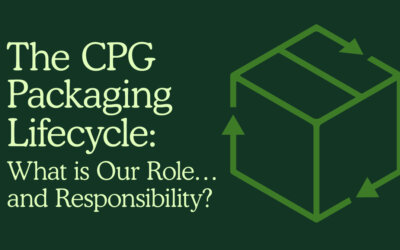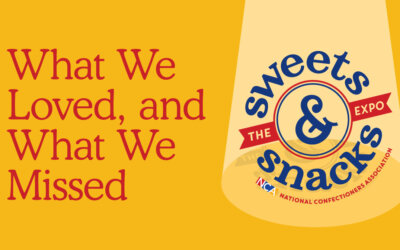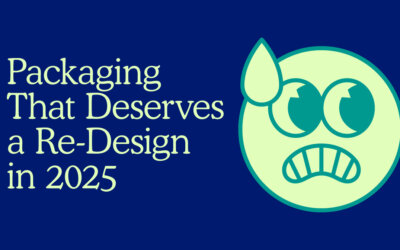What To Watch
Sustainable, Premium, and Tech-Driven
the latest material trends in packaging design

Tina Hamilton
Sr. Designer
June 8, 2023
We’re naturally biased, but it’s no secret that packaging design is an essential aspect of modern branding and marketing. Innovative packaging designs are often the key factor that sets a product apart from its competitors: 72% of American consumers say their purchasing decisions are heavily influenced by the packaging design of the products they buy (or don’t buy).
As packaging experts and enthusiasts, we always have an eye out for exciting material and design trends to help our clients’ brands stay relevant. Here are five to watch right now.
01. Sustainable Packaging Materials
Environmental concerns aren’t going anywhere. Many consumers have begun to reject plastic (and even see it as outdated) in favor of more sustainable materials, such as biodegradable plastics, recycled paper, bamboo, metal, glass, or pulp—eco-friendly options that send a stronger message of corporate responsibility and concern for the environment. The fact is, sustainability really cannot be considered a trend anymore, but a global necessity.
How can you make sustainability ownable for your brand? Identify what your organization does differently and express it through your branding, as Seedlip has done. It’s important not to “green wash,” but to really commit to a level of environmental consciousness to be considered authentic and trustworthy.
02. Minimal and Eco-Friendly Packaging Materials
Minimalist packaging designs are becoming increasingly popular, with many brands opting for simple, clean designs that dramatically stand out on the shelves. Minimalist packaging is often made from eco-friendly materials as well, like recycled paper or biodegradable plastics. These materials are not only better for the environment, but they can impart a fresh, modern feel to the products they house.
Long a signal for “healthy” and “natural,” muted color palettes often comprise the branding for organic foods. If these attributes apply to your brand, consider the strong feelings around trust and honesty that color can evoke.
03. Skip Transparent Packaging Materials
Current market research reveals that clear packages and windows are becoming less desirable. In 2020, Frontier Psychology showed that there were no statistical differences between responses to “transparent” and “graphic” stimuli, suggesting that both can efficiently increase product attractiveness and purchase intention. But transparent packaging leaves less room to influence purchase with brand and product story, graphics, and messaging.
Brands are taking back valuable space on pack to tell compelling stories and finding that it does attract consumers’ attention and can serve as a purchase driver. Many understand that while windows offer a behind-the-scenes product view, those packages are also likely engineered in a way that inherently limits environmental friendliness. Brands are listening to consumers and making commitments to redesign packaging to be more sustainable. CPG giants like Mars are redesigning packaging for better circularity by removing mixed substrates, while other brands have been forced to redesign their packaging due to supply chain disruption.
04. Luxury Packaging Materials
Packaging design is not only about practicality, but also about conveying “premiumness” and exclusivity. Luxury packaging materials like velvet, satin, and gold foiling add a touch of elegance and sophistication to a product, and can deliver on brand equity if your brand is known for these characteristics. Luxury materials are particularly popular in high-end beauty and fashion products; next time you’re shopping, take a look and see what you find.
05. High-Tech Materials
Emerging high-tech materials are becoming more accessible to designers, opening up a new world of possibilities for packaging design. Smart materials like thermochromic ink that changes color with product temperature or NFC-enabled packaging that interacts with a smartphone can create a more interactive and engaging packaging experience. Consider Hilight—printed electronics™, the world’s first illuminated packaging based on electroluminescence. Used for Bacardi’s “Bombay Sapphire” product, the packaging is designed to light up as soon as the buyer takes it off the shelf.
Let The Consumer Drive Your Packaging Material Choices
Each packaging material trend has its own advantages and disadvantages. As brand stewards, designers, and marketers, we must make sure to understand our clients’ needs, their target audiences, and their products’ overall brand equity when choosing materials for packaging design. By staying on top of the latest trends, we can create innovative, sustainable, and engaging packaging designs that resonate with consumers.
More Insights
The CPG Packaging Lifecycle: What is Our Role…and Responsibility?
How would packaging design change if we cared as much about its afterlife as we do its shelf impact? How can we apply creativity, insight, and practicality to every stage of a package’s lifecycle? And what might we discover when we follow our designs beyond the shelf and into the systems that give them a second life?
What we Loved, and What we Missed at Sweets and Snacks 2025
At Sweets & Snacks 2025, flavor innovation stole the show, but something was missing. While branding dazzled, structural packaging design barely made a ripple. We’re diving into why that matters and where brands could be pushing the boundaries. Curious what was overlooked? Let’s unpack it.
It’s 2025. This CPG Packaging Deserves a Re-Design
From impossible-to-open seals to wasteful single-use plastics, we asked our team what packaging frustrations they’d love to fix this year. The answers? Smarter resealability, better portioning, and sustainability upgrades galore. See what made the list—did your biggest packaging pet peeve make the cut?



